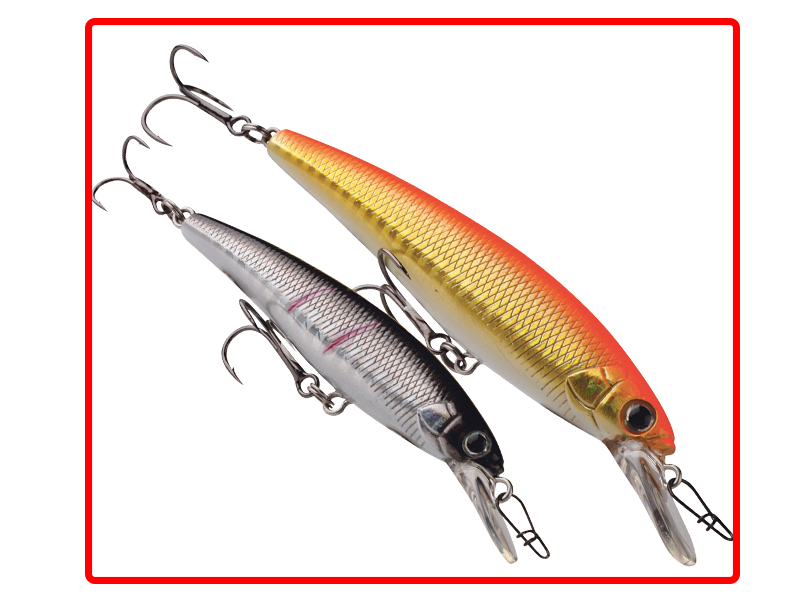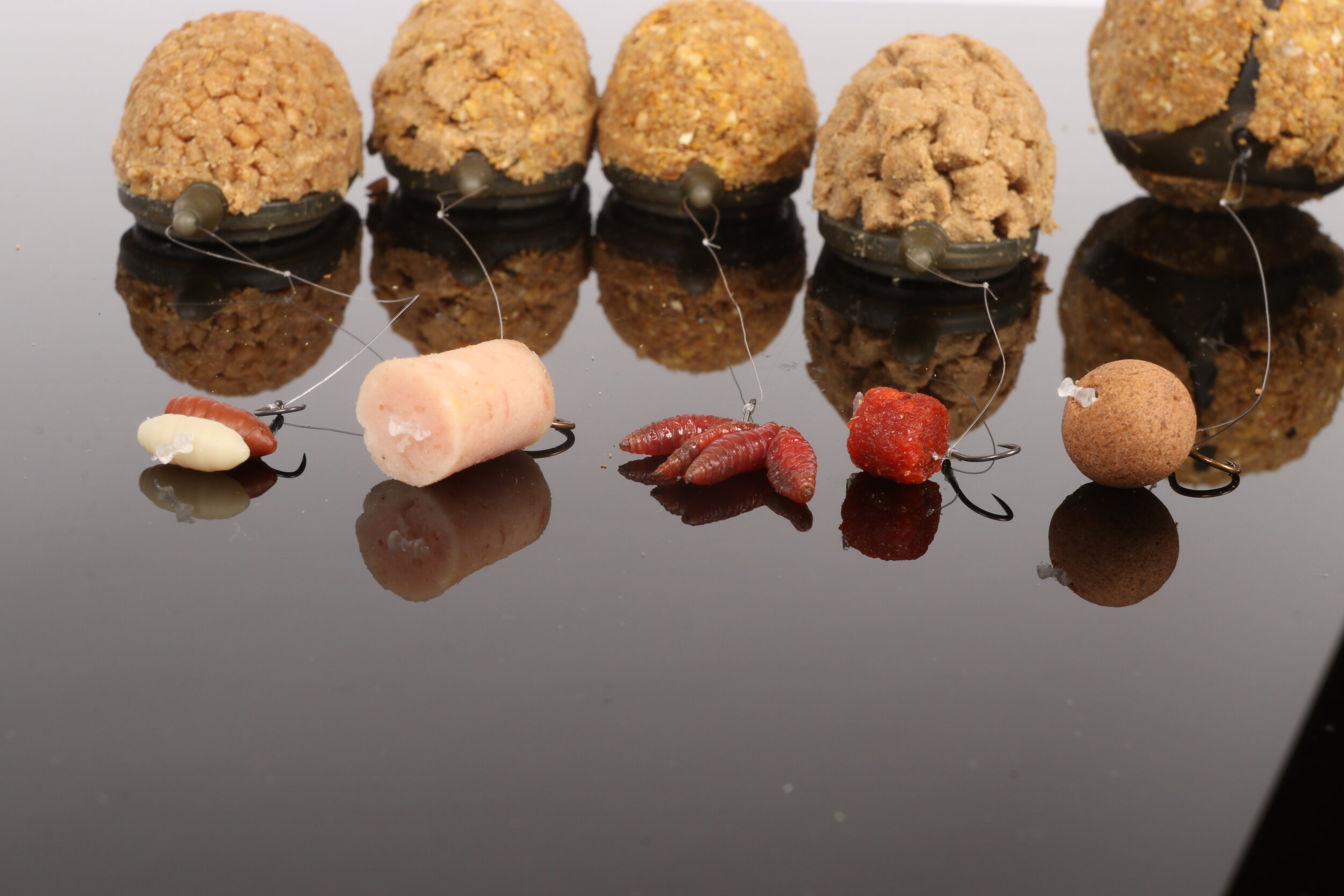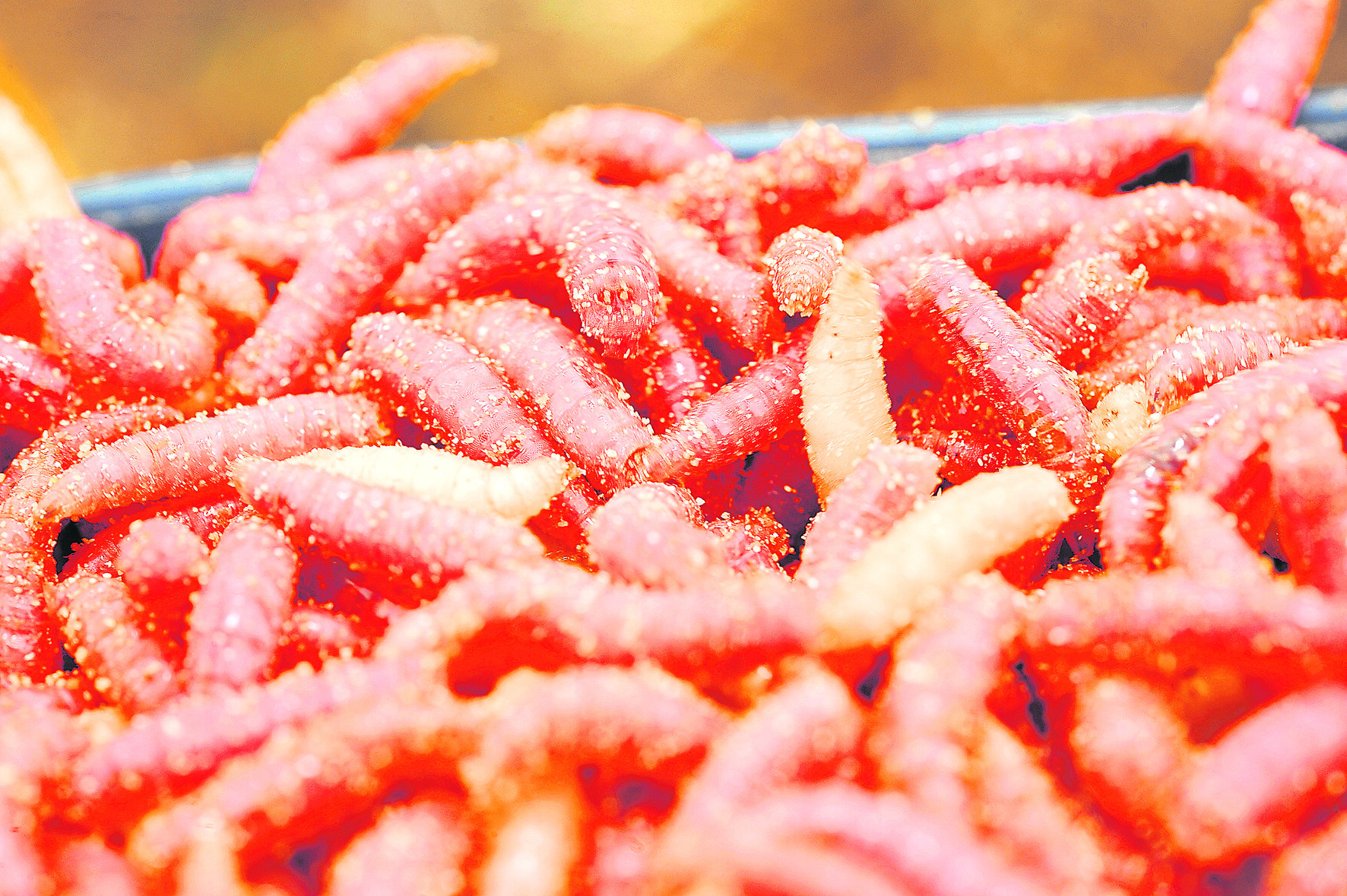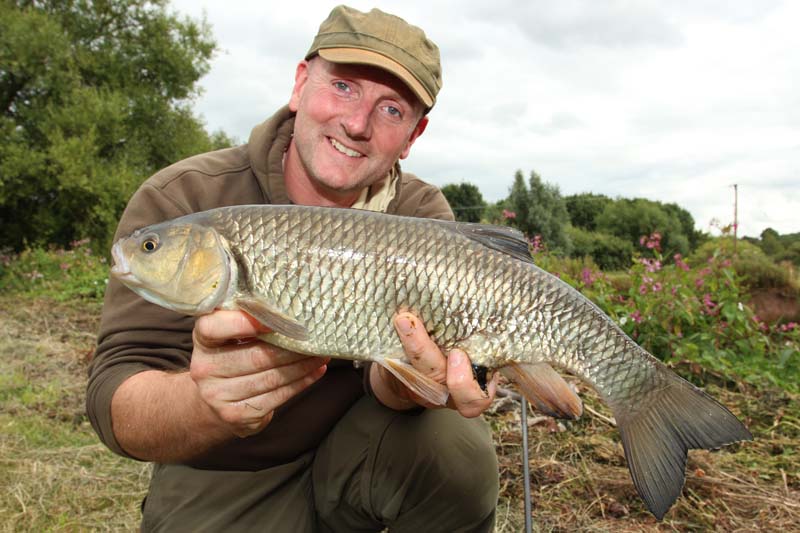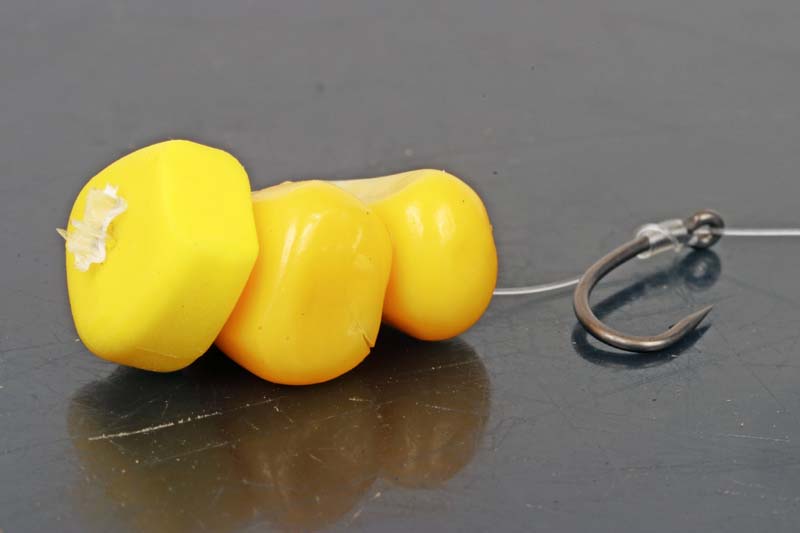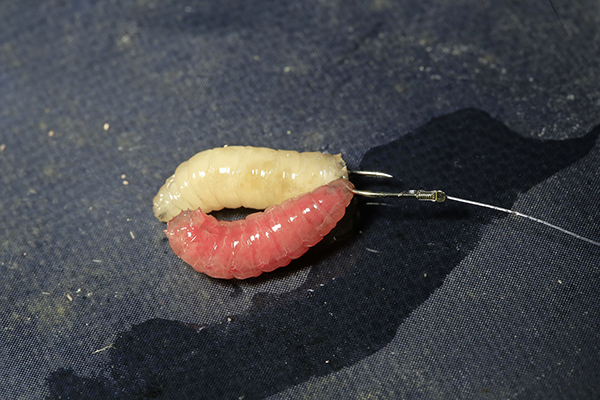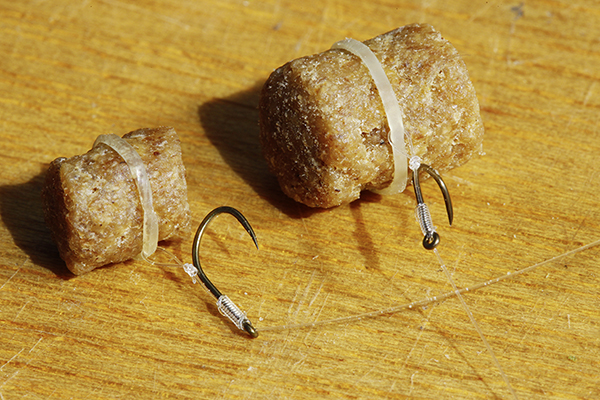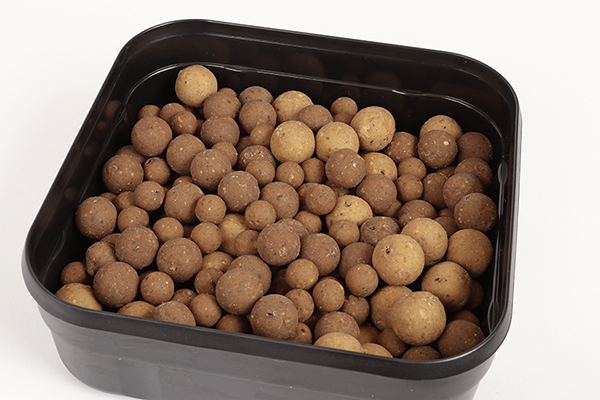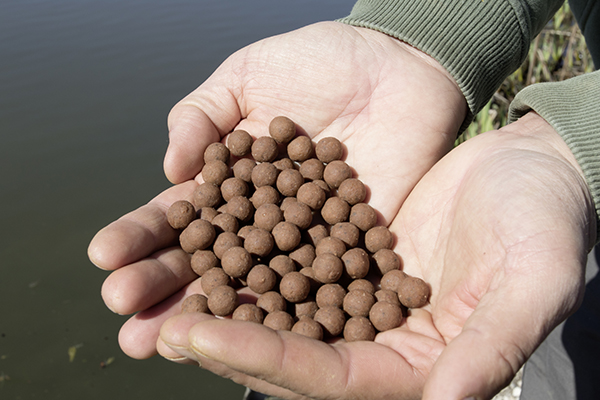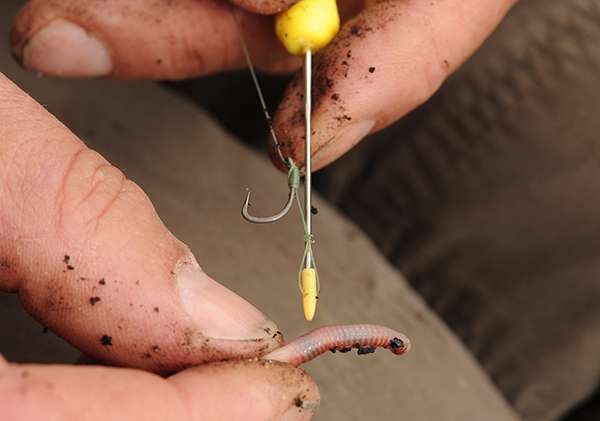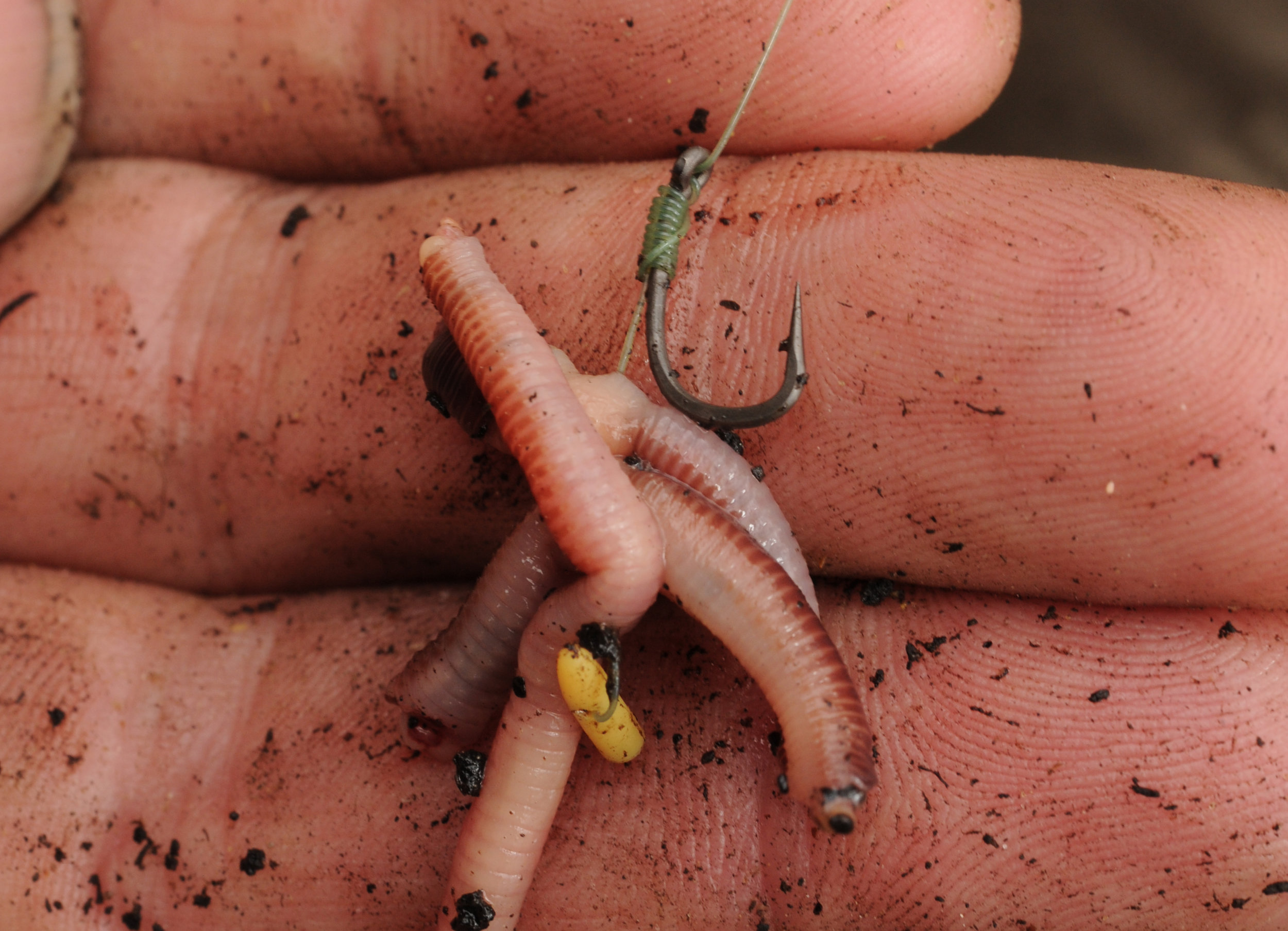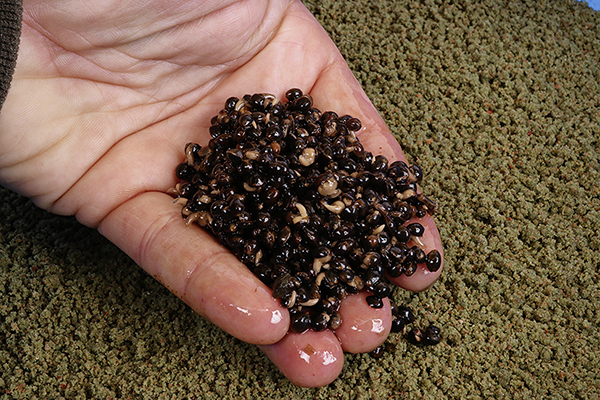Barbel fishing bait | TOP tips for barbel paste
Barbel love paste, whether it is wrapped around a boilie or on it’s own, it’s a must have bait for any barbel angler. To help you make the most irresistible barbel bait around we’ve put the best tips for paste together to help you. Take a look below and let us know how you get on.
Paste is very much a bait for all occasions, if it’s warm or cold you can’t go wrong with it.
But many anglers seem to think that it is only something to slip on the hook when carp are the target – they couldn’t be more wrong!
All fish love a nugget of paste, from shy-biting crucians to big roach and massive tench. It’s all down to the softness of the bait and the scent trail it gives off as it slowly breaks down in the water.
The minefield comes, though, when deciding which type of paste to use because this is a bait that can be tinkered with to achieve very different results.
The softness of paste can be regulated, as can its colour, scent, consistency and breakdown rate.
Fortunately, it is very easy to get hold of a paste that will cover every eventuality. Here is Angling Times’ big-fish man Jake Benson’s guide to picking the right paste – every time.
Stringy paste
There was a time when very few pastes existed if you wanted a tough bait that would stand up to being cast out on float or feeder.
Not now, though. Several companies produce pastes with an added secret ingredient – normally plant protein extract – which gives the paste a tough, almost stringy texture.
Such pastes can be used straight out of the bag and feature a fibrous texture that can be stretched apart in your hands without the bait breaking apart.
These pastes are not only good for long casts, but also come in handy when trying to avoid small fish that would otherwise whittle a soft paste down to nothing.
Pellet paste
Many commercially available pastes are made from ground pellets – and for a good reason.
Fish love pellets, and in many fisheries they see an endless supply of them. It’s so easy to make a crunchy pellet-based paste that’ll appeal to bream, tench, crucians and carp.
A coffee grinder is a must-have here to reduce a couple of pints of 4mm hard pellets into a powder (you can pick from halibuts, plain coarse or coloured and flavoured carp pellets). However, to get that all-important ‘crunchy’ texture it is important to leave a few lumps of larger bits of pellet in the mix.
To bind the crushed pellets, whisk up two egg yolks. At this point you can also add a teaspoonful of any liquid additive such as molasses or hemp oil to boost the pulling power of the paste. Slowly add the powder to the egg mix until a soft paste is formed. Keep kneading the paste until it attains a soft, putty-like consistency.
Groundbait paste
To create a super-soft paste you only need to slightly over-wet a carp-style groundbait. Because of its soft consistency, this type of paste is ideal for fishing at short range for crucians, tench and big roach.
The finished product will be almost runny, but with just enough body to stay on the hook. You can further enhance it by rolling or dipping the paste in hemp or micro pellets.
Ready-made paste or DIY?
Is it better to make paste fresh on the day or buy it ready-prepared? You can’t beat fresh paste made to your own specifications and you’ll know that the consistency is just right for the job in hand. Ready-made pastes don’t offer this, but it does no harm to have a tub stashed away in the bag in case you run out of your home-made mix.
Boilie paste
Made with eggs instead of water to make it much tougher, and using the same ingredients as top boilie recipes, this is a paste to wrap around boilies or large pellet hookbaits.
It’s designed to break down more slowly than traditional pastes, so you can leave a wrapped hookbait in place for several hours, happy in the knowledge that the wrap is still pumping out plenty of attraction. Big-carp anglers use these, but they’re also deadly for big bream and tench.
Boost your groundbait and catch more river bream
At this time of year, even a single day of rain is enough to send river levels up and add colour to the water. When that happens, bream become a reliable target.
Spurred into feeding by this influx of water and reduced visibility, these fish can appear after months of absence. In mild weather, 100lb is possible when you land on a hungry shoal on slow-flowing venues – but it’s far from a case of simply throwing a feeder out and bagging!
We asked England international and former FeederMasters champ Darren Cox for his tips on river bream succes in these conditions.
Choose your peg
“The first consideration is where in the peg to fish. I look for any large areas of slack water, whether thaey are caused by a bay or water running off a bend.
“The point where a river opens out from narrows is another guaranteed bream area. They love slower water, as not only is there reduced pace but natural food and silt will gather, resulting in a big larder for them to get stuck into.
“The silt will be full of bloodworm and the bream won’t move far from here. To find a silty bottom, cast a feeder or bomb out and wind it slowly back across the river bed. Resistance as the lead digs into the silt tells you you’ve found what you’re looking for.”
Add some fishmeal
“With colour in the water, bream feed by scent, not sight, so a groundbait to go in the feeder needs something powerful to stop them – that means fishmeal. I’ll mix up a ‘normal’ bream blend of sweet groundbait but also add a good helping of a halibut or plain pellet-based mix. This is mixed fairly dry to empty out quickly.”
Feed and hookbaits
“Keeping with the positive theme, I try and cram each feederful with as many particles as I can. That’s casters, chopped worm and dead maggots lacing the groundbait, because a big bream can demolish a feeder of bait in one go. Imagine this happening with a dozen fish in the area and you can see how much feed needs to go in.
“For the hook, nothing can beat worms on a coloured river, and while a dendra or lobworm tail is good, I swear by two large redworms tipped with a dead red maggot. Redworms wriggle like mad, and a bream can pick them out far quicker than three dead maggots, for example.”
Keep the bait going in
“I’ll cast every five minutes, even if I’m not getting bites to keep the bait going in on a regular basis – you have to be positive. Clipping up and aiming to a far-bank marker will put the feeder in the right place each time.
“If I cast and immediately get a knock on the tip this tells me that the fish are not backing off and that they want the feed, so you need to try and read the timing of the bite. If I am left waiting five minutes for an indication then the fish could be backing off.”
The feeder is king
“Rod and line is the only option for tackling a slack at range – the waggler just won’t present the bait still enough. That means it’ll be an out-and-out feeder job. Rigs for a slow river are nothing special, made up of the feeder running on the mainline that has a short 4ins twizzled length above the hooklink, for a semi-bolt rig effect.
“Mainline of 6lb is perfect, with a 30g wire cage feeder heavy enough to hold bottom in the slower water. A hooklink of 2ft 6ins or 3ft made up of 0.16mm Garbo Line will put the bait well downstream of the feeder, which is where you often find bigger bream sat below the feed picking off particles. That only leaves the hook to pick, and I can’t fault a size 13 Kamasan B711.”
Kicking off
“Six feeders of bait go in at the start and I would expect indications quickly. If nothing happens after half-an-hour but I am getting small fish knocks, this tells me more bait needs to go in so out go another six feederfuls.
“If nothing is happening at all then it will be a bit of a waiting game so you’ll need to leave the feeder out for longer and wait. Provided you are on a bream peg and conditions are right, there’s no reason why they won’t feed.”
Best baits to use to catch big perch
With the cold weather upon us it is time to start thinking about big perch and what baits to use when trying to lure a a PB into your net. We have taken a look at the best baits to be using right now when it comes to catching big perch.
For more great tips from top anglers head to this year’s The Big One Show
Worms
Few perch can resist a worm, with big lobworms picking out the specimens, while smaller redworms will catch smaller fish when the going is tough.
Lures
Perch will always chase a lure around, and small spoons and spinners take their share of fish – just be sure to use a wire trace in case of pike.
Livebaits
If fishery rules allow, a small live roach or minnow fished under a loafer-style float will produce, fished close to ambush spots.
Prawns
Commercial fishery perch seem especially fond of a tiger prawn fished on the float or sometimes freelined at close range.
CRUNCHY CRUSTACEANS
Signal crayfish are a scourge, but where you find these invasive crustaceans you also find big perch.
You can mimic crays with a raw peeled prawn, even on venues that do not hold crayfish. You don’t need very many prawns for a days fishing – I cut each one in half for a more manageable bait. Even so, a size 8 hook is required to match the bait size.
I never feed whole prawns, as they are very filling. On a cold day a perch might only need one to fill it up. Instead, I recycle used hookbaits by finely dicing them with scissors and feeding this ‘mush’ a little at a time.
If you are roving around and fishing several swims, a good tactic can be to introduce a bit of bait into the next swim before fishing it. Don’t go mad – a single mashed-up prawn or two chopped worms will be plenty to get the perch looking for more without overfeeding them.
Worms
I’VE yet to find a better bait for perch than the humble worm. The only problem is that they can be too good, and on venues with a lot of other fish it can be impossible to get through to the perch. On rivers in particular, though, worms reign supreme. Dendrobaenas are good, but there’s no denying that a lobworm is better by far.
With this year’s dry summer collecting lobworms has been difficult, but fortunately you can buy them easily, either from your local tackle shop or via mail order.
Lobworms are not a cheap bait, but as with prawns you don’t need many for a perch session. I will feed dendrobaenas and save the lobs for the hook to keep the price down, often using half a worm as a hookbait.
If I am floatfishing or planning on recasting a leger regularly I will simply hook the worm once through the saddle. The odd one will wriggle free, but this can be solved by hooking a maggot on after the worm to secure it.
When I expect the baits to be left out for longer, I will switch to a hair-rigged worm, using two Quick Stops to hold it on the hair.
This is a very effective presentation that allows the hook to be scaled down to a size 12 and gives very easy-to-hit bites, as the perch tend to hook themselves.
Attraction
Big perch will often be found in small groups, and it is important not to introduce too much bait. I am sure that on occasion my chances have been ruined when I have given the fish a few mouthfuls of food, which has been enough to satisfy their hunger.
Rather than try to attract the perch these days I focus on attracting their prey, especially on commercial fisheries, where small silver fish are top of their menu. A regular sprinkling of maggots will attract small roach, which in turn will get the perch active. In clear water try adding a small amount of groundbait too, as this will pull in more small fish.
Big perch really are a sight to behold, particularly on a frosty morning. I bet you can think of a few venues close to home that hold some nice fish, so what’s stopping you?
With just the simplest of tactics and a few well-chosen baits you could soon be putting the net under a plump stripey.
STORING LOBWORMS
Lobworms aren’t cheap or that easy to collect at this time of year, so it pays to look after them well.
Use a large bait tub with holes in the lid and add plenty of damp leafmould, some shredded newspaper and a little soil. Store the tub out of the sun in a cool but not freezing spot, and change the mix every week to keep the worms alive for several months.
Six steps to a big autumn stripey
When it comes to catching predators by design, watercraft is king.
Thinking about what you’re doing and, more importantly, what the fish are doing, will not only save you precious time, but also deliver the kind of sport you’re after.
One angler who understands watercraft only too well is Fox Rage expert Gary Edmonds. Gary has been lure fishing for decades, and seems to have a sixth sense for tuning in to what predators are getting up to.
“There are no hard and fast rules to it,” smiles Gary as he steps on to the banks of his local Rib Valley Lakes, ready to cast for perch. “But in general, if you apply the right thinking, you can usually work out where they’ll be – and from there you can work out what it’s going to take to catch them.”
1) Timing
Get out of bed early for the best chance of catching perch, which will usually be very active just as the sun rises. “It can be hard work, but it’s usually worth it,” Gary explains.
“Depending on conditions, you’ll usually get a good hour or two of activity.” This early morning action is based on light levels. The predators make use of the cover of shade and this, combined with their superior eyesight, gives them an advantage over prey fish.
“The same is true of dusk but,
in my experience, it’s first light when you really have the best chance, especially with perch,” says Gary.
2) Light
Light, and the amount of it, has a big impact on the activity levels of predators. But that’s not just confined to first and last light.
“Realistically, the best days are dull, with a good ripple on the water which breaks up the light under the surface even further,” Gary explains.
“Even when the sun is up high and bright overhead, some of the worst conditions, you can still use light levels to your advantage.
“I look for a number of things. First off, natural shade from trees and bushes always works well. That contrast between the dark and bright water areas will attract predators which will hang in the cover of the shadows. Areas such as the margins of islands that are in shade are always great to try if you can reach them.”
3) lake topography
The underwater make-up of a lake has a huge impact on where you will find your target species.
It’s easy to just think of the bottom of the water in front of you as sloping off and then being fairly uniform, but that is hardly ever the case.
“It’s crucial to get a good idea of what is happening in front of you so you can fish for the predators in the most likely spots and make your fishing more likely to result in bites,” Says Gary.
“If you don’t know a water, it’s worth taking the time to cast your lure around and count it down on a tight line, waiting for it to touch bottom, at which point the line will go slack. You’re looking for variations in the time it takes for your lure to reach bottom. That will indicate changes of depth.”
These changes of depth are the areas that Gary will spend his time fishing, be that a steep drop off, a hole, a bar in open water, or in a fairly uniform area, even just a slight dip – all can be enough to hold fish, especially perch.
“Predators will be looking for areas where they can sit and gain a tactical advantage over their prey,” says Gary, casting out his lure.
“That could just be light cover as they sit lower down on a slope, or lurk on the far side of a bar.”
4) Temperatures
“In the winter, as the temperature drops the fish will be slow but still need to feed, although this can be in small windows of time during the day,” explains Gary,
“They will also look to have a more stable temperature that is less affected by sudden drops caused by overnight frosts and the like. They look to go to deeper water which is more temperature-stable, and that’s where you will most likely find them.
“On days when the temperature lifts, prey fish will move to shallower water which will warm up more quickly, and the predators will follow. On those warmer winter days I will quite often target the slightly deeper water behind shallows where I can see prey fish. This can result in some great sport.”
5) Man-made areas
Although they are always talked about in terms of fish-holding spots, man-made structures such as pontoons, walls or anywhere that will give fish cover will attract prey and therefore predators, and so they are definitely worth covering.
“If the water you’re on is fished a lot these will normally be the spots that get the most pressure, as they are the most obvious,” says Gary. “But they are still worth your attention. Structure in depth of water is what you really want. Something offering shade and cover ticks a lot of boxes with all fish – all you need to do is approach it differently to other anglers, whether that’s getting there earlier, fishing it later, using different sized or actioned lures or trying different techniques like weedless deadsticking.”
“Man-made structures really come into their own on what appear to be uniform, barren waters, such as canals and drains.
“If you have no discernible features and then suddenly find an outlet pipe or even a shopping trolley in the water, there will normally be fish around it.”
6) Techniques
In cold weather, cold water will result in cold fish that are less active, so you need to adapt to catch them. “One of the best techniques for lethargic fish is drop shotting,” explains Gary.
“In these conditions, working a jig slowly enough to get them to bite properly can be very difficult, but if you know where the fish are, a drop shot approach will allow you to present a lure effectively in the same place for as long as you like.
“This will get their attention, hold it and tease them into striking, especially if you have a shoal of perch in front of you. They will become competitive, and it puts them under pressure to hit a free meal before another fish does.”
Best lures for pike fishing
With predator season upon us it’s time to dust off your lure box and get back out there. To help you choose the right lures for you next pike fishing session we have gone to our weekly columnist Paul Garner to get his opinion on what lures you should be taking out on your next session.
Lure fishing is exploding in the UK right now, as many anglers discover the joys of casting artificial baits for a wide range of predatory fish.
On my local canal you are now likely to find just as many anglers drop shotting for perch with small lures as you are fishing the pole.
Head to the coast, and piers and jetties are frequented by anglers targeting a myriad of different marine species with their LRF (Light Rock Fishing) gear, armed to the teeth with soft plastics.
All fish are predatory to some degree and I have seen bream, barbel and even dace caught fair and square on small lures, so there really is something for everyone.
For me, though, nothing beats fishing for big pike with lures and that electric feeling that signals a ‘hit’ from a big predator just can’t be beaten.
CHEAP AND RELIABLE
I am an avid collector of lures, but increasingly I find soft plastics dominating my tackle box.
These deceptively simple rubber fish-shaped baits come in a wide range of different outlines and sizes, but they all work in much the same way.
You can buy soft plastics either pre-rigged, or as bare lures that enable you to rig them just the way you like. Best of all, they are among the cheapest lures you can buy, making this a great way to get into lure fishing for pike.
Pre-rigged lures are the ideal place to start, as these will be rigged for optimal performance.
Once you have learnt how to use these, swap over to rigging your own so you are able to fine-tune your presentation. Go for lures in the 6ins/16cm range, as these will be the easiest to cast and will catch pike of all sizes.
SLOW AND STEADY
There is absolutely no need for any complicated retrieves with soft plastics. You simply let them sink to the desired depth and reel them in! The odd pause to let the lure sink back down will also often bring a bite, as the change in speed triggers a pike that is following the lure to take it – but ‘slow and steady’ is my mantra.
To keep the lure working in the right depth zone use one gram of weight per foot of depth.
So, on rivers and canals I use 5g lures, on lakes around 10g, and on deep reservoirs anything up to 30g.
A really useful skill to practise is counting the lure down until it hits the bottom, which you can feel as a distinct bump.
Once you know how long it takes for the lure to reach the deck, you can count it down to any depth you want very easily.
Try to mix up the depths that you are fishing at. Some days the pike will prefer a lure presented just beneath the surface, while on others they want it right on the bottom.
These simple soft plastics really are very effective, and will catch plenty of zander and big perch as well as pike if you scale down the size a little.
Why not give these popular lures a go this autumn?
Chub Fishing Baits | Best baits for big chub
We asked bait expert Paul Garner what his best baits to go chub fishing with were and he came back with five amazing chub baits that will make sure you land your biggest ever chub on your next session.
The scorching weather of the past few weeks has had a big impact on my river fishing so far this season.
For more great tips from top anglers head to this year’s The Big One Show
With barbel off the menu, I have spent some enjoyable evenings stalking chub on my local rivers instead. The low, clear water conditions have been perfect for this, with the dark shadows lurking under the overhanging branches of bankside trees giving away the presence of my quarry.
Location is rarely a problem with chub – you know they are never going to be far away from cover at any time of the year, and a good flow will attract them too, even if the water is only knee-deep. Persuading them to take a bait can be a different proposition, though, especially if they have been fished for, as their superb eyesight and uncanny ability to spot anything out of the ordinary can make them frustratingly difficult to catch.
With time, and a steady supply of maggots or casters, you can overcome this natural caution and often catch most of the fish in a shoal, but I prefer to roam the river, looking for fish and making just a cast or two in any likely-looking spots before moving on to pastures new.
Fishing like this, especially if you can follow the path of the bait and the reaction of the fish, can teach you a lot about the behaviour of the wily chub in your local river.
Choice of bait is important, and although I will normally only carry one or two types with me at any one time, there are five that stand out as the best for summer chubbing.
SLUGS
Not for the squeamish, but by far the most effective chub bait that I have ever used, slugs elicit an instant reaction from chub that has to be seen to believed.
The loud ‘plop’ of a slug hitting the water will attract any chub in the swim and within seconds those white rubbery lips will engulf a freelined bait. If you don’t get a bite on a slug then you can be pretty sure that there are no chub in the swim!
While my garden is full of slugs in the spring, hot weather can make them difficult to find, just when you need them most.
Look in any dark corners of the garden, especially first thing in the morning. Compost containers are often home to loads of slugs and are the ideal places fom which to collect them. There are several different species, and the chub love them all! Store your slugs in a cool, dark spot and they will last for several days.
WORMS
When I find it impossible to collect slugs my second choice, although it can be hit-and-miss, is worms. You won’t find a worm that is too big for a chub, so go for the largest you can find, as this will add casting weight.
The bigger the worm, the more it can resist the attentions of small fish. Just as with slugs, you are likely to get a bite on the first or second cast as the chub home in on the splash. If no reaction is forthcoming it’s best to move to a new spot and try again.
Hooked once through the ‘saddle’, worms will last for several casts if they aren’t gobbled up first. Although not as dense as slugs, worms can still be lobbed a reasonable distance without any additional weight needing to be added.
LUNCHEON MEAT
I always keep a couple of tins of meat in the car. Although not the most effective chub bait, a cube of meat can save the day when other baits are hard to come by. I treat meat just as I do slugs, hooking a large cube on to a size 8 hook and freelining it into any likely-looking spot. One benefit of meat is that its light colour is very easy to follow as it slowly sinks and drifts downstream.
Often, the bait will simply disappear as a chub swallows it.
BREAD CRUST
On larger rivers it can be difficult to spot chub, especially if they are holding station in mid-river. In this situation you can still freeline a bait and simply watch the line for bites, but often a different approach is more effective.
On hot, windless evenings chub will often take emerging insects off the surface and we can make use of this behaviour to catch them. The crusts of a fresh loaf make the ideal bait, pulled into chunks and allowed to drift downstream. Pay particular attention to crease lines, where chub are likely to hold station.
Follow the crusts downstream until you spot the tell-tale splashes of chub picking them off. Once the chub are feeding confidently like this the hookbait is likely to be taken straight away.
TINY LURES
For sheer fun and excitement, few methods beat light lure fishing for chub. A splashy lure fished on or just beneath the surface will often bring a response. Try fishing really shallow swims where the broken water gives way to a steady glide. Often chub will be here feeding on minnows and other small fish.
Alternatively, try using more imitative lures – grasshoppers, crayfish and tiny fish patterns – that can be mounted on a 3g jig head and bounced across the bottom of shallow swims.
Expect the unexpected, and don’t be surprised if this tactic catches other species too.
Five amazing baits for summer bream
Want to land a big net of specimen bream this summer? Then check out these great bait tips for bream from bait expert Paul Garner as he has put together the ultimate list of bream baits to help you catch more now.
For more great tips from top anglers head to this year’s The Big One Show
Every summer I try to put together a good catch of bream.
This could come from a river or a stillwater, as both types of venue can contain shoals of slabs averaging 5lb and upwards.
My tactics are simple, but effective. The Method feeder is my first choice, loaded with a groundbait mix that won’t break the bank.
A lot of rubbish gets talked about how much bait you need to catch bream. Sure, a shoal can number dozens, if not hundreds, of fish, but remember – you are trying to catch them, not feed them! My experience is that heavy baiting for bream can be counter-productive.
If the fish are following a patrol route then no amount of bait will persuade them to stop. Introduce too much and they will leave most of it, including your hookbait.
A couple of kilos of bait is more than adequate for a day or night session. The bulk of this will be groundbait, with a tin of sweetcorn and some pellets and mini-boilies thrown in for good measure. If I have some frozen maggots in the freezer they will go in too, but they are just the cherry on the cake and not essential.
CHEAP GROUNDBAIT MIXES
Bream do love fishmeal groundbaits, and a mix that contains plenty of crushed pellets will certainly do the trick.
It’s surprising how little fishmeal is needed in the mix to have an effect, though, so to cut costs I will use a 50-50 combination of groundbait and brown crumb, to bulk out the bait. Remember, though, that brown crumb does not bind particularly well, so this could well affect how much feed the groundbait can hold.
I use soaked flaked maize a lot. This resembles cornflakes in its dry state, because that is essentially what it is! When soaked it swells up and emits a milky haze with soft flakes that bream (and carp) really like.
I use molasses to flavour and sweeten the groundbait – I find it to be most effective for bream, and it’s cheap. You can buy it by the litre from animal feed shops.
Sweetcorn
Bream love corn. Its yellow colour and salty taste make it easy for them to locate and they will spend a lot of time eating every grain. This makes it a top hookbait too and I normally use two or three grains on a hair to make the hookbait stand out. Because this is a relatively soft bait, look for grains that are fully intact. Try combining two pieces of real corn with a buoyant flake bait to produce a brilliant wafter.
Mini-boilies
If I am night fishing then 12mm boilies will often be my hookbait of choice, simply because they are long-lasting and I can have total confidence that they will still be there come morning. For bream up to about 8lb I use a single 12mm bait, but for bigger specimens I find two 12mm baits brings more bites. Try a sweet flavour, such as Strawberry Crush.
Dead maggots
Live maggots can attract too much attention from small fish, even though they are a brilliant day-time bait. Switching to dead maggots both in your feed and on the hook can avoid this problem, as their lack of movement doesn’t attract as many small nuisance tiddlers. Try using a bunch of four maggots on a size 14 hook for best results.
Worms
Worms can be problematic if you are on a venue with a lot of small fish, but on a
low-stocked pit they can be very effective. Try to get hold of some small lobworms – no more than 4ins long. I like to hair-rig these, adding a piece of buoyant corn to not only give the bait some buoyancy, but also to act as a giant bait stop.
Pellets
Bream love pellets, especially high-oil halibut pellets, and two 10mm baits hair-rigged in tandem have caught me a lot of big bream. You can buy ready-drilled baits that are very easy to rig, but the hole can be a little too large for a normal bait stop. Try using a Quick Stop, or add a tiny square of elastic band before the stop.
How to prepare sticky micro pellets
Micro pellets need to be prepared quite differently to normal fishery pellets. Instead of soaking them it is much better to very slowly add water directly to the pellets, just as you would if mixing groundbait. This stops them breaking down and turning into concrete!
For more great tips from top anglers head to this year’s The Big One Show
1) Add a good glug of Scopex Squid Syrup to a pint of water and stir well until the syrup has dispersed.
2) Mix a handful of 3mm pellets with a bagful of sticky micro pellets and put the pellets into a shallow mixing bowl.
3) Slowly add the liquid while keeping the pellets moving all the time. Only add more water once the initial liquid has been absorbed.
4) When the pellets have reached the right consistency they should stick together when compressed in your hand, but break down to a mush when rubbed.
Tench fishing baits | How to make Jelly pellets
Summer is here which means it is a perfect time to go out tench fishing. However finding the right bait to use can be quite difficult which is why we've asked bait expert Paul Garner to walk us through this great tench fishing bait so you can try it out at home.
Pumped expander pellets are ideal for tench and crucians, giving that key soft texture that is so important.
Adding a small amount of gelatine to the water gives the soft pellets a more robust texture, meaning they will stay on the hook better.
For more great tips from top anglers head to this year’s The Big One Show
1) Add a teaspoonful of Scopex No1 flavouring and a similar amount of red powdered dye to a pint of warm water.
2) Add a sachet of gelatine powder to the warm water and stir constantly until the gelatine crystals have fully dissolved.
3) Half-fill your pellet pump with 6mm expander pellets and then pour the dyed and flavoured liquid over them.
4) Pump the pellets then leave them to stand under pressure for about six minutes, or until they have all sunk, whichever is the sooner.
5) Release the pressure and pour off the excess liquid. The pellets will still be quite hard, but will soften as they absorb more liquid.
6) Store the pellets in an airtight container. A tablespoonful of squid powder coats the pellets, giving them even more attraction.
Margin baits for shy biters
Tench and crucians are species synonymous with summer.
Crucians, in particular, are making a resurgence around the country and there is now a good chance that you will find some in a fishery close to you. Despite these two species preferring the warmth of summer they can be finicky feeders, thanks in part to the abundance of natural food.
Back in spring fairly crude tactics work well enough, but now a more measured approach is required.
Often, tell-tale knocks on the float will give away the presence of the fish, but hittable bites can be few and far between.
For more great tips from top anglers head to this year’s The Big One Show
MELT-IN-THE-MOUTH BAITS
Soft baits are definitely the way to slow down difficult-to-hit bites from both tench and crucians at this time of the year. I think a soft bait feels more natural, so the fish hang on to it that bit longer.
When the fish are feeding well the bites are sail-aways – the float simply buries as the fish moves on to the next bait.
There are a few soft baits that you can try. A small pinch of paste is one option, soft hooker pellets are another. Both these baits are easy to prepare, although you can buy them ready-made if you prefer. I like to prepare mine fresh to get the consistency just right.
Making my own bait also means that my feed will contain the same ingredients as the hookbait – a custom-matched pair.
GROUND PELLETS
I like to use pellet powder to make my paste. You can soften the whole 3mm pellets up by soaking them in water overnight, but to get a finer and more consistent bait, grind the pellets to a powder – it really makes a difference.
You can add other powdered ingredients to your pellet powder, such as krill or liver powder, to boost the paste.
A soft paste can be made by adding water to the pellet powder. You might find that this bait is a little too delicate and difficult to keep on the hook, so to overcome this, instead of using water to make your paste, trying using egg white instead. The albumen in egg white is a brilliant binder, and will transform the consistency of any paste.
Alternatively, add two tablespoonfuls of wheat gluten powder to a pint of ground pellets and mix with water. The gluten acts as a binder by forming strings of protein in the paste, making it soft but much longer-lasting.
GROUNDBAIT PASTE
If I am using pellet paste I will feed nuggets of the same and fish with a piece about the size of a grain of corn. The smaller the bait, generally the better the bites, but this has to be balanced against using robust tackle, especially hooks no smaller than a size 14.
Groundbait paste is another option, especially if you want to lay down more of a carpet of fine feed and fish a matching bait over the top. You can make groundbait paste using egg white or gluten.
Dynamite’s Swim Stim Green is a perennial favourite of mine for this tactic, once again with a small amount of krill powder added.
HOOKABLE PELLETS
When big fish are in the swim I like my hooker pellets to be slightly more robust than normal.
This comes down to confidence, as often the float will dip and bob as fish bump the line. I want to ensure that the hookbait is still secure and that I can leave the float out until I get a proper bite.
Jelly pellets are ideal for this style of fishing, having that extra robustness that I crave. As the name suggests, these are much more rubbery pellets, made by adding some gelatine to the liquid used to pump the pellets ,which then sets to a jelly-like consistency.
Of course, because I am pumping the pellets I have the option to add extra liquid attractors, and will generally use a small amount of sweet flavour, such as Scopex No.1, to counteract the slightly bitter taste of the gelatine.
You can use larger pellets, but I have found 6mm baits to be perfect for both tench and crucians at this time of the year, with a noticeable drop-off in the number of bites when bigger baits are used. Rather than introduce too many baits at the start, I prefer to drip-feed pellets a pinch at a time, adjusting the feed rate depending on the number of bites.
Unlike carp, which will come up in the water to intercept pellets fed this way, leading to line bites and foul-hooked fish, tench and crucians will tend to stay on the bottom to feed.
Best Tench fishing baits and methods for right now!
ishing for tench this summer and unsure on what bait to use? To help you narrow your choices down we've asked Paul Garner to give us his best methods and bait to help you catch more tench while fishing. See below for the best tench fishing baits and tips for the summer.
Now's the time to catch a big tench, and gravel pits are the best places to do it.
Even though the fishing can at times be frustrating as the fish roll and bubble with abandon, yet hardly give a flicker on the float or bobbin, don’t despair – there is often a very simple answer to this problem, simply by using the right bait…
NATURAL FEEDERS
It’s often claimed that gravel pit tench become harder to catch the further into summer we go. I think this is down to preoccupation with natural food.
As summer continues the density of invertebrates rises by the day, giving the tench a limitless larder. Why eat a lump of bread flake, or a boilie, when they are surrounded by natural food?
Interestingly, I have followed a couple of venues for more than a decade that have developed into big-carp fisheries. I was expecting the tench to tune in to the quantities of boilies being fed right through the year, but no.
Except for a brief window in the early spring when the tench do fall for bright pop-ups, they have steadfastly remained hooked on naturals.
I’m not saying this happens on every tench fishery, but certainly on venues with a low stock of fish and high levels of natural food you could be waiting a long time before getting a bite on some baits.
Fortunately, there is an answer, and a very simple one at that.
MIMIC NATURE
The invertebrates that tench feed on are mainly bloodworm and caddis fly larvae. You can see why tench can be so difficult to catch – just look in the margins of a rich gravel pit. The bottom will be crawling with life as the cased caddis, carrying their tube-like homes woven from bits of reed stem and sand, crawl around looking for food.
How do we go about mimicking this natural larder? One answer, rarely employed in the UK but popular in Europe, is to collect and use caddis larvae as a hookbait.
I can see the logic to this but I would also worry that my hookbait would simply be the needle in one enormous haystack of grub. Fortunately, maggots, casters and worms provide a good enough alternative to be eaten by the most finicky of tench.
HORSES FOR COURSES
I find red maggots are very effective on the venues I fish – they are easy to use and can be stored for a few days. I will have some large dendrobaena worms with me too, as a change bait, should the need arise.
Worms are my first line of attack on older, siltier lakes. These venues tend to have tench that feed mainly on bloodworm, and I guess this is why worms will outscore everything else.
If silver fish are a nuisance, casters are my go-to bait, with a matching artificial hookbait. The tench don’t mind the plastic but the silverfish will certainly be less of a problem. Casters would be my first choice if I had good tench fishing close to home, as storing them on the bank would not be a problem. As I tend to travel a fair way for good tenching, though, storing casters becomes an issue.
FLAVOURSOME
All three of my chosen baits will work just fine as they come at this time of the year.
Tench, from my observations, are very visual feeders, so they will home in on a spread of bait on the bottom without further encouragement.
If you want to try flavouring your baits, particularly maggots, there is only one additive that I will use at this time of the year - Shellfish Sense Appeal, a real humdinger that only needs to be used in minute quantities.
Try adding half a teaspoonful to a pint of maggots to give them a strong shellfish smell. On a tough day I think this extra flavour can make a difference, so it’s worth having a bottle in your bait bag.
HAIR-RIGGING WORMS
A secure way of fishing worms on either the float or feeder is to hair-rig them between two Quick Stops held in position in a large loop on the hair. To pop up your bait, simply add a disc of rig foam.
Pop them up
Tench will often cruise around several feet off the lakebed and cover a lot of ground quickly. If they are in a feeding mood they will drop down to investigate any bait on the bottom.
Normally, I introduce roughly equal quantities of hemp and my chosen hookbait. The hemp is likely to be picked up and blown out by the tench many times over the course of a session. Some will be eaten, but the rest will keep the fish browsing for quite a long time.
The maggots, worms or casters are there to get the tench feeding harder. There’s no need to fill it in. A couple of pints of bait are plenty for a morning session.
One trick that often brings bites much faster than normal is to pop the hookbait up. When fishing maggots this is normally achieved by sandwiching a sliver of rig foam between two or three maggots on the hook.
Rubber casters are naturally buoyant, so use just enough to counteract the weight of the hook. Worms can be injected with air, but I prefer to hair- rig them with a small disc of rig foam to add buoyancy. The foam also acts as a buffer on the cast.
Whether you are fishing a float in the margins, or casting to distant gravel bars with a feeder, using these three baits will prove the key to unlocking gravel pit tench.
Give it a go, you will not be disappointed.
Best commercial fishing baits for carp
Commercial carp can be caught on sorts of bait, to help you narrow your options down next time you are on the bank we've decided to put together this handy little guide to some of the best baits to catch commercial carp on.
For more great tips from top anglers head to this year’s The Big One Show
Double maggot
In cooler weather double maggot will often pick out the better-sized fish. Most top match anglers will fish with one red and one white maggot, as this seems to appeal to F1s more than two of the same colour – crazy but true!
Caster & worm combo
Caster make a fish-attracting noise as they hit the surface and F1s love eating them! However, fishing casters on the hook can result in missed bites and smashed baits. Try a caster-sized piece of worm segment to get around this.
Hard pellets
F1 carp are reared on pellets and love eating them. The 4mm and 6mm sizes are best for this small-mouthed fish. To fish a hard pellet as a hookbait you need to hair-rig a small bait band.
Expander pellets
On lakes with few silverfish, soft expanders are brilliant for F1s. Lift and drop the rig for a rise and fall of the bait. Most anglers use 4mm pellets in winter and 6mm in summer, fed little and often.
Sweetcorn
Most fish like to eat corn, F1s included. In clear water a grain of sweetcorn stands out a mile and it’s also a brilliant bait to fish on a margin rig down the edge. Get a tin which has mixed sizes as you’ll find the smaller grains best for F1s.
Breadpunch
A great bait in colder weather, F1s are suckers for a bit of punch and this hookbait will often get you a fast start to your session if you can drop a small, 6mm disc close to far-bank rushes or features such as aerators.
How to boost your boilie attraction with Paul Garner
I like to boost my boilie hookbaits in several different ways to increase their instant and long-term attraction. If you are fishing in the margins, or spodding out bait, then this is the mixture that I favour.
1) Put together a mixture of different sized boilies, all with the same flavour.
2) Next, crumble some more boilies, again of the same flavour, into the mix.
3) Pour some hot water over the baits – just enough to cover them will be sufficient.
4) Add a teaspoonful of liquid food to each pint of boilies. My favourite is Scopex Squid.
5) Add some hemp oil or tiger nut extract to the soaking baits.
6) Leave the baits to soak and soften for about an hour.
The best bream fishing bait mix
Two-time Drennan Cup winner Dai Gribble reveals what his favourite bream fishing spod mix is. Take a look at the four steps below and try it out for yourself next time you're out on the bank bream fishing.
1) My feed is made up of a mixture of Sonubaits fishmeal and bread-based groundbaits. I will use Supercrush Bream Feeder as a base for the mix but will darken this off with Super Crumb Black Bream. You can make the mix even stickier by adding Super Crumb River to it, and this helps when you’re making long casts on the Method feeder.
2) The groundbaits are blended together first and then are mixed up with lots – up to a pint – of liquid molasses. Molasses is quite dense and very soluble, and a trail of it will leak off the groundbait in the undertow, pulling bream from a long distance.
3) The crumb is supplemented by a mix of Pro Feed and S-Pellet Feed Pellets in 2mm and 4mm sizes – great for keeping fish in the swim for longer – plus a couple of tins of F1 sweetcorn.
4) I also add a small number of the boilies that I use for hookbaits. The critical thing is not to introduce too many of the high-attract baits as free offerings. You want enough for the bream to get a taste for them and hunt them out, but not so many that it reduces the chances of them taking your hookbait.
Generally, I add no more than about 30 boilies, whilst using up to five kilograms of groundbait and pellets.
The best hookbait to use when fishing.
Paul Garner explains what his favourite hookbait is and what makes it so perfect.
What makes the perfect hookbait? Mine would need to have the right texture, breakdown speed and buoyancy. It would be easy to hook, of a perfect flavour and colour, and I’d want to be able to change the size and shape quickly.
That’s a big ask, and most baits fall down on one or more counts, yet I’ve been using one that fits the bill perfectly for two years.
Initially developed for fishing the Method for crucians, my set gel baits have become firm favourites and have caught me loads of different species, from carp and tench to chub and barbel.
The beauty of these baits is their versatility. Easy to make, they can be adapted to suit almost any situation and can be used with a huge range of additives for true customisation.
Gels are long-lasting in water, staying intact for several hours. The outside becomes almost slimy as it absorbs water and begins to break down, creating a lovely flavour trail.
I do believe that fish generally prefer softer baits, and gels offer the perfect compromise between a soft outer skin and a rubbery structure.
WHAT IS IT?
The secret to making my gel baits is a product known as Vege-Gel that you can buy from most supermarkets.
I came across this gelatine substitute when first playing around with set baits, and after some experimentation I found that it worked perfectly. The active ingredients are natural gelling agents that set when heated. Vege-Gel is used in baking, but by increasing the concentration it sets to make the perfect hookbait. Better still, just about any liquid or fine powder can be added to give it a distinctive flavour.
PURE AND SIMPLE
Making gel hookbaits is very easy if you follow my method. On its own the gel has virtually no taste and a clear colour, so it takes dyes and flavours very well.
In fact, if you want a really bright bait, adding half-a-teaspoonful of powdered dye will give you an incredibly vivid colour.
The same applies with liquid flavours and additives. The bland base means that the flavour really comes through. Keep levels very low, though, as it is very easy to overdo the flavour level.
I normally stick to about half the manufacturer’s recommended level. Food dips and liquid foods, which are not so concentrated, are ideal for these baits, giving more margin for error and a much rounder flavour to the bait.
GROUNDBAIT HOOKBAITS
You are not limited to just liquid additives in gels. Powders such as krill, squid and liver can be added – and what about groundbaits?
Imagine being able to use a hookbait that has exactly the same smell as the groundbait that you are introducing! All you need to do is add a handful of dry groundbait to the gel liquid and you will produce baits with the same flavour and colour as the feed. This has proved a useful tactic when fishing groundbait on the Method feeder for bream, as the fish just hoover up the whole lot without even noticing the hookbait amid the crumb.
MICRO-MIX
Another gel technique that I have been trying out is hookbaits incorporating micro pellets.
Initially, I ground the pellets down to a fine powder before mixing them into the bait, but although this worked well, it was time-consuming. Eventually, I tried adding tiny 1mm-2mm micros, and they worked a treat!
Once again, the finished bait perfectly matched the feed, giving me a really distinctive hookbait.
The bottom line is that you can use just about any additives you like to gel baits, and by altering the amount of water added go from a super-soft to a firm finished bait that can be tailored to the style of fishing that you are doing.
Recently I have been using larger baits to target bigger carp, and this has been very successful too.
For bigger fish I make the slab of bait slightly thicker, and once it has fully cooled I cut it into cubes and fish it just like luncheon meat.
My results have been excellent, so why not give it a go?
Dai Gribble's Worm kebab for Tench
Tench are now on the feed and one of the best baits for catching this incredible spring species is worm. We've asked two time Drennan Cup champ to show us his favourite way to rig worms when fishing for tench.
ONE-INCH WORMS
Start by chopping a few worms into inch-long sections and begin threading them on to the hair using a Quick Stop and needle. Dendrobaena worms are best for this.
GO LARGE
I use four sections of worm on a size 10 hook and three on a size 12 – the bigger the hook, the bigger the bait you can use.
MIND THE GAP
It’s important to tie your hairs long enough to leave a little gap between the top of the chopped worm and the bottom of the hook. This gives the bait more movement and leads to better hookholds.
CHOPPED WORM
You’re looking to put a lot of flavour into your feeder, and the best way of doing this is with chopped worm. Don’t turn the worms into a complete mush, though – 1cm long sections are ideal.
FILLING THE FEEDER
I buy my worms supplied in the peat they’re grown on in, as this is packed with attractants too. Start by half-filling the feeder with chopped worms and then add the peat, which I pack tightly into the feeder with my fingers.
ADD LIVE MAGGOTS
Always add a few live maggots to your feeder because these will help to push some of the flavour out when the rig is in the water. You actually want the mix to stay in the feeder as long as possible, creating a big ball of fish-attracting smell. It should only get flushed out when you reel in.
Best carp fishing groundbait mix
A simple fishmeal-based mix will catch plenty of carp, but I do like to add a couple of proven additives and a handful of larger feed items to keep the fish grubbing around. This is a great mix of mine to get you started, but the choice of ingredients really is endless.
The base mix is ground pellet groundbait specifically for Method fishing, as this will bind very well.
Add a small amount of crushed hemp to add attraction and some activity to the mix.
Squid Powder added to the dry ingredients will increase the bait’s carp-attracting properties.
Into a pint of water goes a teaspoonful of food dip or liquid additive as a soluble attractor.
Slowly add liquid to the powdered ingredients. After five minutes you can add more water if required.
Boilie flake adds extra food value to the groundbait that will keep carp grubbing around for ages.
Add 6mm feed pellets to further boost food content. Go easy or the mix won’t bind to the feeder.
The mix should stick together but still break down into crumb when rubbed between your hands.
10 of the best tench fishing tips and baits
Spring is here and so are the tench! We've decided to compile together 10 of the best tench fishing tips and ait for you to use on your spring and summer campaigns for this great species. To help us put together these great tench fishing baits we asked bait expert Paul Garner to give us some of his favourite tench baits.
From floatfishing in the margins, to long-range feeder fishing, the tench angler has to master many different methods, and learn how to get the best from the available baits.
My tench fishing evolves over the coming weeks as the fish change their behaviour, but there are some tactics that come into play each season for me and which have stood the test of time. Let me share them with you...
1) shellfish maggots
Maggots often figure very highly in my tench fishing.
Being easier to store than casters, maggots are a convenient choice that have caught me tench on every venue where I have tried them. I always use the freshest and cleanest maggots that I can buy. Every few days I change the maize flour that I store them in, as this does become sour, even if the maggots sweat.
There is one additive that I always use on my maggots when tench fishing, and that is Shellfish Sense Appeal. Just a few drops of this smelly shellfish extract added to a pint of maggots will have a big impact on my catches, and I never leave home without it.
2) Yellow pop-ups
When tench are just getting going in the spring, a highly visible bait often scores really well.
I noticed a few years ago that carp anglers tend to catch tench at this time of year on their chod rigs, especially when using small yellow baits. Following suit with a scaled-down approach, I found myself catching loads of tench on 10mm pop-ups fished on a mini chod rig.
I think that any tench that is cruising past can spot the yellow hookbait very easily, and more often than not will eat it. Don’t expect this tactic to last for very long, though. For some reason it loses its effectiveness by the middle of May.
3) hemp as a holding bait
Hemp is a great bait for attracting and holding tench, but I am not convinced that they actually eat much of it.
Underwater filming has shown that tench often pick up hemp but then blow it back out again, rather than swallowing it.
This has certainly influenced how much hemp I introduce, and now I rarely use more than a pint per day. I like to introduce this on a little and often basis, keeping that lovely nutty smell topped up, but not introducing too much bait.
4) Cocktail Baits
You can often get extra bites by combining two tench baits on the hook, especially if you have both baits in your loosefeed.
Try a combination of worm and caster, or maggot and corn, to produce a bait with some movement and more bulk than either bait on its own.
5) Sweetcorn
At one time sweetcorn was talked about in hushed tones, so effective was it as a tench bait, but in recent years it has certainly fallen out of favour with many tench anglers.
This is a shame, as it is still a fantastic bait and if it hasn’t been used heavily on a venue it will often work really well. Carp anglers often introduce lots of corn in their spod mixes, yet never use it on the hook, so they are effectively prebaiting for you!
I normally use two grains on the hook when floatfishing to create a nice visible bait. If you are legering, try a combination of one real and one fake piece of corn.
A small tin of corn is more than enough for a tench session. Try feeding six grains after every bite to keep the fish interested.
6) worm rigs
Worms can be quite difficult to fish with, especially if you are legering, as they have a tendency to work their way off the hook.
Overcome this by tying up a hair rig with a rubber caster and a Quickstop on the loop in the hair.
Push the Quicsktop through the worm leaving it fixed between the stop and the rubber caster, and it will not be able to escape. Use a short hair so that the worm is just below the bend of the hook.
The caster not only adds a small amount of buoyancy, but also stops the worm wrapping itself around the hook.
7) krill groundbait
Most anglers wouldn’t associate tench fishing with using groundbait, but a few years ago now I stumbled across a great combination that works very well in both a cage and Method feeder – and the tench love it!
I use a 50-50 mix of Dynamite Swim Stim Green groundbait and Krill Meal, and have found this to be supremely effective. Be careful not to over-wet this mix. It needs to be mixed slowly, so that the water is fully absorbed, until you are left with a fluffy texture that binds together quite well.
The Krill Meal is quite expensive, but fortunately you do not need a lot of this groundbait as I use it purely on the feeder – so half-a-bag is plenty for a day session.
8) Casters
Casters are a very effective tench bait. I use them on venues where small fish make using maggots difficult. This is not because they are second-best, but because maggots are easier to store both on and off the bank.
Try using two parts casters to one of hemp to keep tench grubbing away all day. There is no need to use real casters on the hook – although you can if you want to – but rubber casters are just as effective and far easier to use. Store casters in the fridge, in an open container so that they can breathe and stay slightly damp.
9) Fantastic plastic
Whether it is a bunch of rubber casters, a piece of fake corn, or a plastic pop-up boilie, tench will readily take artificial baits, and so often these can make the fishing so much easier.
I like to keep a range of different fake baits in my tackle box for occasions when small fish make using real baits difficult, or when I want to leave a bait out for several hours at a time.
Don’t worry that they have little natural smell – you can always try dipping plastic baits in additives, or fish them straight from the packet.
10) match the hatch
Very often tench can become harder to catch as the summer wears on. I think this is because their natural food become more abundant and they can pick and choose what they eat.
I tend to switch to smaller baits, such as maggots, by about June when the tench can be more picky.
It is also worth raking the swim lightly before fishing to disturb the natural insects on the bottom. This will draw in the tench and get them feeding hard.
How to make zig rig soup
With water temperatures starting to rise, it's time to start think about using zig rigs when you're next out on the bank. Here is a great recipe to help you lure those specimen carp to the upper water layers and help you catch on the zig next time you are on the bank.
Add a few handfuls of breakdown pellets to a tub of water and let them fully dissolve. The fine particles left are ideal for the soup, being neutrally buoyant.
To bulk out and increase the cloudiness of the mix you can add some maize flour. This will also save you a bit of money into the bargain.
Ground hemp is naturally buoyant, and carp love the taste of it, so it is an ideal ingredient to add. A handful is plenty, though, as it is quite expensive.
When well soaked, flaked maize sinks very slowly, so add a a handful to give the mix more food value – but make sure it is properly soaked so that it sinks.
Mix all the ingredients well and cover them with water. Leave the soup for as long as possible – for best results, overnight – to absorb all the water.
Add a tablespoonful of Plume Juice to the mix to flavour and colour it. I prefer sweet flavours in the spring, as the carp react very well to the sugary taste.
If the mix is a little watery, add just enough fine brown crumb to help it bind together. Bear in mind, though, that this is a ‘soup’ and should be quite runny.
The best way to fish with worms
Few baits are as attractive as worms, but unfortunately this can pose a problem if a lot of small fish are present. You can get through a lot of bait trying to feed off the tiddlers to get to the bigger fish, especially if you are feeding chopped worm. If this happens, try feeding whole worms, or chop them roughly to leave big chunks.
Feeding finely chopped worm can also be a problem, as the bait is very slow sinking.
A good way to overcomeg this is to feed the worm in a small amount of molehill soil, just enough to bind it together.
If you use groundbait then only add the chopped worm as and when you need it, because the salt in the feed will quickly dehydrate the worms.
I remove any soil from the worms by rinsing them in a maggot riddle before chopping. This makes them much easier to chop, and the cutter blades last longer.
Use a pair of choppy scissors to cut a handful of worms into bite-sized chunks. It’s well worth investing in a pair, which makes the job of chopping far quicker.
Add a handful of maggots to bulk out the feed. The colour is up to you, but reds are favoured by perch and skimmers, and stand out well in clear water.
Use a small bait dropper to introduce the bait, even on stillwaters, to ensure it all gets down to the bottom and doesn’t bring the fish up in the water.
Different types of worm
There are several different species of worm that you can buy or collect yourself for bait.
Some, like the lobworm, have been in use for thousands of years while others, such as dendrobaenas, are relative newcomers to the angling scene, and are easily farmed.
Lobworms
If you collect your worms from a lawn on a warm damp night, or put them to one side when digging the garden, then the chances are you are using proper lobworms.
Our native earthworm can grow up to 25cm in length and is probably the best worm hookbait that you can get.
I prefer to keep lobworms back for use as hookbaits only, and feed easy-to-come-by baits such as dendrobaenas or maggots.
Just about every fish that swims will eat a juicy lobworm, but they are especially favoured by perch and chub.
Dendrobaenas
Much smaller than a lobworm, dendras rarely measure more than about 12cm, and have less girth too. That said, their size and availability make them a great bait, both on the hook and as feed.
Because of their smaller size, dendrobaenas make a good bait for smaller species, and can be combined with maggot, caster, or corn to make excellent cocktail baits.
Redworms
Collected from well-rotted horse manure heaps – which sounds more unsavoury than it actually is – redworms are another small species of worm, but one that is very effective.
A favourite of the tench angler, a single redworm, or a worm tipped with corn, has resulted in the capture of a lot of big fish down the years.









